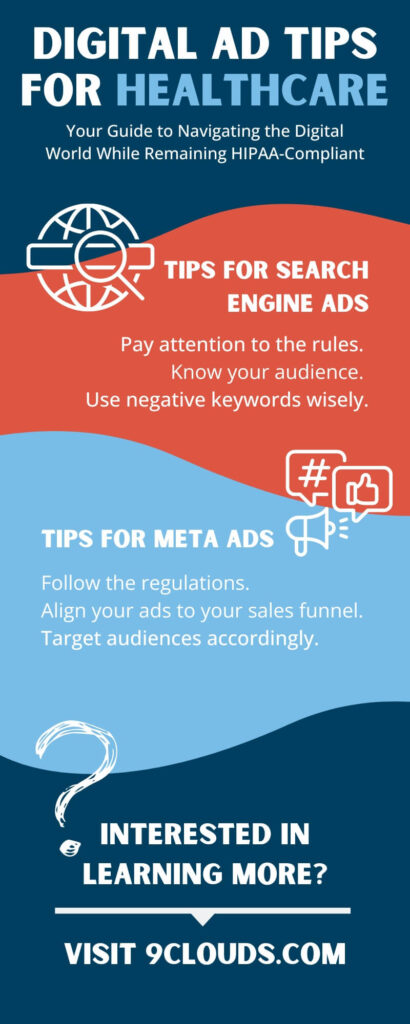
Effective Digital Ads Tips for Healthcare
In today’s tech-filled world, healthcare is rapidly evolving, and how we connect with patients is changing just as swiftly.
This digital landscape comes with its own set of challenges, especially when it comes to protecting patient privacy and following the regulations set by the Health Insurance Portability and Accountability Act (HIPAA).
Trekking through this digital world by yourself can be hard, so let us be your guide.
Here are some digital ad best practices we recommend for your healthcare practice on search engines and Meta platforms (and an infographic at the bottom to show our points).
Tips for Search Engine Ads
When people are looking for anything — including doctors, medical information or other healthcare — they search online for it first. With search engine marketing (SEM) on Google and Microsoft (where your ads show on Bing, DuckDuckGo, Yahoo and more), you show at the top of those search results pages (SERPs).
With 8.5 billion searches made every day just on Google, it makes sense to include search engine marketing (SEM) for your healthcare practice. And if you’re facing a lot of competition in your area or haven’t built up your search engine optimization (SEO) yet, these digital ads can help you outrank those other businesses.
But what goes into great healthcare digital ads on Google or Microsoft? Follow these tips!
Follow The Regulations
Both Google and Microsoft have specific rules in place that you need to follow if you want to run ads:
1. No Promotion of Banned Services and Products
If you want to promote certain products, such as CBD oil, don’t expect to promote it on these search engines. Google and Microsoft provide full lists of banned products.
Certain products can reach a limited audience rather than being outright banned on Google. With a special certification, you can advertise them in a limited number of countries.
2. Phrasing Can Be Tricky
Yes, Google and Microsoft will tell you what you can and can’t say — including requiring certain phrasing that you must include.
For the most part, the phrasing you can’t include is within reason. For example, if you’re a sex therapist, there are certain phrases you’ll have a harder time getting approved because Google would deem it as adult content.
When promoting healthcare services or products, the rules also say you have to mention that some things just can’t guarantee specific results. Take, for instance, a weight loss service flaunting ‘before and after’ pics. You’ll need to throw in a disclaimer like “Results may vary.” Gotta keep it real!
3. No Retargeting Campaigns
Google specifically does not allow retargeting campaigns for healthcare-related accounts. (Retargeting campaigns are when you re-engage with past web visitors or people who have clicked on your ad.)
Use Your Keywords Wisely
The keywords you target (and don’t target) can make or break your campaigns. Here are some tips on keywords to make sure your ads show up in your customers’ searches.
1. Know Your Audience
When figuring out the keywords you want to target, you need to understand what people could be searching for and where they are in your sales funnel. That means knowing if they’re just looking for more information — or if they’re ready to schedule an appointment.
If your practice is trying to target people who are at the bottom of the funnel, you should target keywords such as “price,” “screening,” “appointment,” or “procedure.”
2. Add Negative Keywords
Let’s say you’re an optometry office and want to advertise glasses — prescription eyeglasses. You don’t want to show up for searches for “wine glasses,” “window glass repair,” “automotive glasses” or any other types of glasses. That’s where negative keywords come in.
Negative keywords are when you exclude search terms that might be similar to keywords that are associated with your medical practice. These are just as important as the keywords you do target. You have to tell Google what searches you want your ads to show up for — and which ones you don’t.
Tips for Meta Ads
Now that we got through the behemoth that is search engine advertising, let’s talk about the next giant: Meta advertising.
More than 30% of the world’s population is on Facebook and Instagram. (That’s more than two and a half billion people.) Facebook ads reach the most users of any social platform. They also provide robust targeting options for your medical practice.
But what goes into great Meta advertising for healthcare? Glad you asked! Follow these tips.
Follow The Regulations (Meta Version)
Just like advertising on Google and Microsoft, there are certain regulations that you need to follow to have your ads approved on Facebook and Instagram.
HIPAA compliance is the main thing you need to worry about for Meta ads. Offline events are not allowed for medical advertisements, which makes sense. You need to keep your patient’s information confidential and secure.
You also need to avoid certain phrasing in your ad copy. This goes along the same guidelines with Google and Microsoft advertising. Don’t make absurd claims or include taboo phrases.
Target Your Desired Audience
Sure, you aren’t allowed to use offline events for your Meta advertising — but that doesn’t mean all hope is lost. You can still match your services to your known demographics.
You know your patients and understand who would benefit from your services the most. When you use Meta’s targeting features, you’re able to show your ads to the exact people who are most likely to be interested.
Think of it like this: instead of casting a wide net and hoping for the best, you’re honing in on specific age groups and interests. It’s like having a super-targeted bullseye for your advertising efforts!
Uploading patient lists for targeting may not be allowed, but you can use custom audiences based on people who have engaged with your practice’s ads, social media posts, and website visitors. Simply place the Meta Pixel on your website to capture traffic and retarget those people. Also, lookalike audiences can be used for top-of-funnel campaigns to attract similar audiences to the ones you already have.
Follow the Funnel
Each marketing strategy you implement should be strategically positioned within the sales funnel – a concept that is still relevant in the realm of healthcare.
Grow Your Practice with 9 Clouds
Looking to grow your medical practice digitally? Do it with help from the 9 Clouds team.
We have helped a variety of healthcare organizations stand out online. Our healthcare Meta ads and SEM campaigns consistently perform better than the healthcare benchmarks, and we’re here to help you!
Get More from Your Digital Ads »






